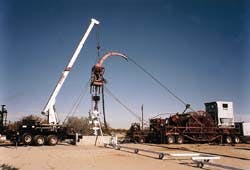Larry S. Adams
Chevron USA Production Co.
Midland, Tex.Charles C. Overstreet
CUDD Pressure Control Inc.
Houston
Coiled tubing is being run into the well to drill out scale
A recent workover shows the technical capability and cost effectiveness of coiled tubing for cleaning out scale in a 22,611-ft, low pressure, high-temperature gas well.
The well, operated by Chevron USA Production Co., is in the Fort Stockton Gas Unit 5-1 Gomez (Ellenburger) field, in West Texas.
The development of reliable 100,000-psi minimal yield strength coiled tubing was a major factor that allowed this work to succeed.
The methods demonstrated by this workover are becoming a standard for deep well cleanouts in the Gomez (Ellenburger) field.
Coiled tubing advantages
Recent advances in coiled tubing technology have improved the economics of performing deep underbalanced workover operations. Use of reliable 100,000-psi minimum yield strength coiled tubing is now the preferred method for these types of operations.
Coiled tubing technology provides significant economic and technical advantages compared to conventional workover practices. Major advantages are:
- Lowered transportation cost
- Reduced rig-up and tear-down expense
- Less logistical coordination
- No kill fluid
- Reduced/eliminated reservoir damage
- Reduced tubular trip time
- Eliminated/reduced safety hazards.
Well history
The well Fort Stockton Gas Unit No. 5-1 (FSGU 5-1) produces from the Gomez (Ellenburger) field in the Delaware basin on the southwest flank of the Central basin platform (Fig. 1 [21737 bytes]). Development of the Gomez (Ellenburger) field started in 1963. No remedial operations were performed on the FSGU 5-1 since its completion in March 1970 (Fig. 2 [30781 bytes]).
In July 1993, while acquiring bottom hole pressure data, an obstruction was tagged at 21,164 ft from surface. An attempt with a 1.5-in. bailer deployed on slickline failed to obtain any samples of the obstruction. However, based on offset well data, it was assumed that scale with major physical characteristics of calcium carbonate and iron oxide caused the restriction.
In August 1993, the first acid treatment since the well was completed had no effect on its producing characteristics. Because FSGU 5-1 was considered a prolific producer relative to offset production, it was determined to remain risk adverse and not attempt any further remedial activity.
FSGU 5-1 produced an average 4.7 MMcfd during the first quarter of 1996 with a 900-psi wellhead back pressure. Based on a detailed nodal analysis simulation study in August 1996, wellhead compression was installed, and wellhead back pressure was reduced from 900 psi to 500 psi.
Although production increased by 1.6 MMcfd because of this compression, nodal analysis still indicated a potential for producing an additional 2.0 MMcfd.
Based on offset well information, a 94% soluble scale interval beginning at 21,164 ft from surface existed and was restricting the well's inflow performance. But historic data indicated a minimal probability that a surface acid treatment could contact enough scale surface area to dissolve the restriction.
Because the surface acid treatment was unsuccessful, the next plan was to drill through the scale section and use a wash tool along with acid to remove any remaining scale rings.
Treatment design
A well bore cleanout feasibility study was initiated to compare the potential for cash flow enhancement, indicated from the nodal analysis, to the risk of losing all of the production.
The study evaluated the technical and economic risk for clean out operations in the well. It compared costs and risk of a through-tubing underbalanced coiled tubing scale cleanout to a conventional scale cleanout performed in February 1995. The comparable conventional method required a rotary drilling rig and removal of production tubing.
The conventional scale cleanout cost $866,000. Although this work successfully restored 82% of the well's prior production, only 80% of the perforated interval was cleaned out because of differential sticking. Also, 4,910 bbl of fluid were lost to the formation.
The estimated cost of the alternative through-tubing underbalanced scale cleanout technique was a maximum $110,000 and it had the potential of eliminating fluid loss to the formation.
Because of the potential 87% cost savings, the coiled tubing cleanout option was selected.
A risk analysis based solely on mechanical failures and fishing operations during tubing changeouts compared coiled tubing installations into existing tubing strings and through-tubing workovers performed on Chevron-operated wells in the Gomez (Ellenburger) field. This study indicated that coiled tubing for the scale cleanout eliminated the 89% risk of fishing operations and the 11% risk of losing the well bore.
Project design focused on the coiled tubing, cuttings removal combined with minimized formation damage, and on the bottom hole assembly (BHA). All these factors are interrelated and should not be designed independently.
The workover required designing and manufacturing a 1.5 in., 100,000-psi minimum yield strength coiled tubing string with seven inside wall diameter tapers. The tapers ranged from 0.095 to 0.156 in. wall thickness.
The overall length of the string was 23,000 ft with a consistent overpull design of 9,060 lb. This overpull design was based on 72% of the coiled tubing's minimum yield value.
Using the well's average shut-in bottom hole pressure of 2,100 psi, the annular velocity for carrying cuttings to surface was evaluated. This study indicated that no particles greater than 0.1 in. could be brought to surface without maintaining a full stabilized column of 65% or greater foam quality.
Further analysis indicated that during actual operations the prolonged development and maintenance of a full well bore column of 65% or greater foam quality would be difficult. Conceptually, it was highly desirable to use acid for dissolving the particles.
An HCl acid package, 15% by volume, was selected because of the iron content in the scale and need for high solubility under short contact time. The appropriate corrosion inhibitor package was based on testing coupon samples from the 1.5-in. coiled tubing string manufactured for the project.
The coupons were exposed for an 8-hr period to six various inhibitor packages blended in an acid system consisting of 15% HCl, acetic anhydride, foaming agent, and friction reducer.
The coupon weight was recorded and compared to the initial weight, and a corrosion rate was calculated in lb/sq ft/test time.
Because of its tolerance for high temperatures and flexibility for being powered with gas, fluid, or both combined, a 1.688-in. OD impact drill was selected for deployment on the coiled tubing. The impact drill was manufactured of Inconel 725 material.
A 2.25-in. OD button-bottom bit was selected because of its historic success in removing tubing scale. The bit body was built of Inconel 725 material with tungsten buttons. A 1.687-in. OD wash tool was placed directly above the impact drill and was actuated by pumping a 0.5 in Teflon ball down the 1.5-in. coiled tubing.
The total length of the bottom hole assembly (BHA) was 8.07 ft and was manufactured of Inconel material (Fig. 3 [26634 bytes]).
A generic project procedure is described in the box.
Implementation
Fig. 4 [21206 bytes] shows the equipment and the surface injection and flow line configuration. Total on-site operation with coiled tubing equipment took about 50 hr.
Fig. 5 [27292 bytes] shows the coiled tubing unit rigged up on the well.
Although water separation was being handled through an existing on-site, two-phase separator and dumped into an existing water tank, a flare pit with capability of handling about 200 bbl of fluid was excavated.
Continuous reservoir inflow was maintained throughout the coiled tubing operation phase of the project.
The BHA installed on the coiled tubing was tested with nitrogen as the power media. Overpull checks taken at various depths ensured that the coiled tubing design limitations were not being reached.
While running in the hole, excessive drag was encountered at 11,800 ft. This was believed to be scale buildup in the area of the tailpipe assembly at 10,000-10,200 ft (Fig. 6).
After encountering the excessive drag, the BHA was pulled uphole to 9,500 ft and pumping of freshwater combined with foamer and nitrogen for generating a 65 quality foam system was initiated. After making a wiper run through the tailpipe assembly containing the profile nipples and taking various overpull checks to 13,700 ft, water injection was stopped and the nitrogen rate was increased.
Good foam continued to be returned to surface until a depth of 18,700 ft was reached.
A restriction was tagged at 21,167 ft which was 3 ft deeper than the depth restriction tagged by slickline operations in July 1993. Upon contacting the restriction, the impact drill was actuated with 400 lb of weight being applied. The tool was allowed to drill off to 200 lb, based on surface weight indicator readings.
Nitrogen was pumped at 1,100 scfm with a 1 bbl acid sweep pumped every 15 min. The acid sweep aided in scale removal and dissolved particles that might be present in the coiled tubing annulus. This process removed six scale intervals that ranged in thickness from 58 to 1 ft. Upon reaching plug-back TD at 22,611 ft, a 0.5-in. Teflon ball was pumped downhole for closing the impact drill and actuating the wash tool.
The perforated interval, 22,602-21,098 ft, was acid washed with 2,000 gal of a 65 quality foam acid system using the wash tool. Injection rates were 0.5 bbl/min of acid and 1,100 scfm of nitrogen.
The BHA was pulled uphole to 10,200 ft while continually pumping nitrogen. From 10,200 to 10,000 ft, 1,500 gals of acid with 500 scfm nitrogen pumped through the wash tool removed any possible scale buildup across the tailpipe assembly.
After completing this process, the BHA was pulled out of the well while pumping a neutralizing solution of 500 gal of potassium carbonate. Then 20,000 scf of nitrogen displaced the contents of the coiled tubing.
After pulling the coiled tubing, the well flowed a stabilized 9.3 MMcfd against a backpressure of 80 psig prior to pumping a 160 bbl nitrified acid treatment down the production tubing. This treatment ensured near well bore reservoir cleanup.
After a 30 min shut in, acid load flowback was initiated. Within a 48-hr flowback period, full fluid was recovered and the well began flowing at 8.3 MMcfd, unloading 12-15 bw/d against a line pressure of 550 psig.
Acknowledgment
The authors wish to thank Chevron USA Production Co. and Cudd Pressure Control Inc. for permission to publish this article. n
Generic project procedure
STEPS INVOLVED IN A COILED TUBING scale drill-out job are as follows:
- Have two 500-bbl frac tanks, one for source water and one for fluid returns. Ensure source water tanks are clean. Fill one source tank with 250 bbl of freshwater. Ensure that liquid friction reducer is on location for adding it to the freshwater, should it be necessary.
- Dig work pit. Install a flow line to manifold coming off wellhead. Stake down flow lines as necessary. Maintain well's production through surface facilities for as long as possible before diverting flow to work pit/flare.
- Rig up 11/2-in. coiled tubing unit and acid and nitrogen equipment. (Rig up for a 24-hr operation.) Provide a 10 micron surface filter for the source fluid.
- Install 111/16-in. OD impact drill with 21/4-in. OD cut-button bit (all components are to be constructed of Inconel alloy 725), 111/16-in. OD wash tool, and 2-ft by 111/16-in. OD extension joint on 11/2-in. coiled tubing.
- Test impact drill before running in hole to ensure proper actuation with water. Test all treating lines, wellhead, and coiled tubing with water to 5,000 psi for 15 min.
- Run in hole impact drill on 11/2-in. coiled tubing. Monitor and report coiled tubing drag and string weight at 5,000 ft, 10,000 ft, 15,000 ft, 20, 000 ft, every 500 ft between 20,000 ft and tag point, tag point, and at each critical point thereafter.
- Upon encountering fill, initiate impact drill using nitrogen and / or acid. Clean out fill to plug back TD.
- At PBTD drop/pump 1/2-in. Teflon ball down 11/2-in. coiled tubing and shift open wash tool. Pull out of hole, in this case to 21,000 ft, with 11/2-in. coiled tubing spotting 2,000 gal of 15% HCl acid across open hole.
- Displace coiled tubing with 2 bbl of water/N2 spacer, neutralizing solution, and 20,000 scf of N2. Rig down acidizing equipment.
- Pull coiled tubing out of hole.
- Acidize down production tubing with 6,700 gal of 65 quality nitrified 15% HCl with additives at a maximum rate of 6 bbl/min and 4,000 psi surface treating pressure. Displace to top perforation with nitrogen. Shut-in well for 30 min and begin flow back operations.
- Rig down coiled tubing unit and nitrogen equipment once acid load recovery is initiated.
- Turn well over to production group and monitor production rates.
The Authors
Larry Adams is a petroleum engineer for Chevron USA Production Co. He joined Chevron in 1981 and has held various production, reservoir, and drilling assignments in West Texas.Adams earned a BS in petroleum engineering technology from Oklahoma State University in 1980.
Charles C. Overstreet is a special project engineer for Cudd Pressure Control Inc. in Houston. He has 5 years of experience in oil field work. Overstreet has a BS in mechanical engineering from the University of Texas.



